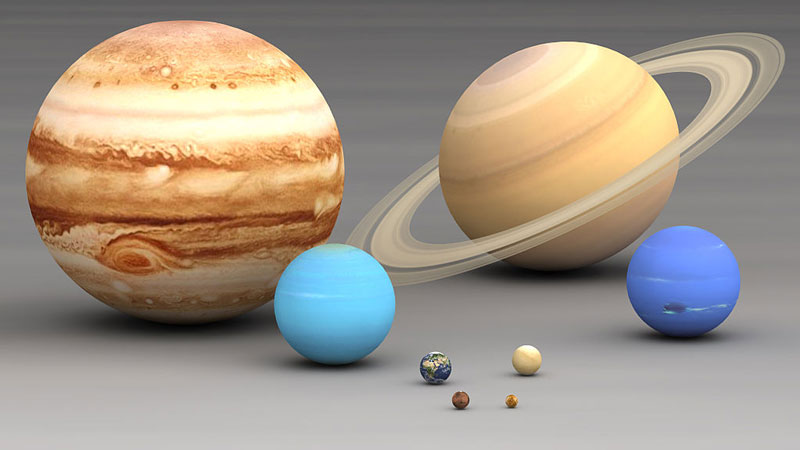The table below shows relevant data in relation to the sizes of the planets. Note, however, that planetary sizes can be measured in different ways; i.e. by mass or volume (circumference/diameter).
| Planet | Mass | Mass in relation to Earth | Density | Circumference at the equator | Diameter at the equator |
| Mercury | 3,302×1023 kg | 0,055 | 5,43 | 15,329 km | 4,879 km |
| Venus | 4,8685×1024 kg | 0,815 | 5,24 | 38,025 km | 12.104 km |
| Earth | 5,97219×1024 kg | 1 | 5,52 | 40,075.16 km | 12,756.1 km |
| March | 6,4185×1023 kg | 0,107 | 3,94 | 24,343 km | 6,794 km |
| Jupiter | 1,899×1027 kg | 317,83 | 1,33 | 439,263.8 km | 139.822 km |
| Saturn | 5,6846×1026 kg | 95,152 | 0,70 | 378.675 km | 120.536 km |
| Uranus | 8,6832×1025 kg | 14,536 | 1,30 | 159,354.1 km | 51.118 km |
| Neptune | 1,0243×1026 kg | 17,15 | 17,204 | 154,705 km | 49.244 km |

Here is a comparison of the sizes of the planets
The size of the sun and moon
Below is relevant data for the sizes of the sun and moon:
| Object | Mass | Mass in relation to Earth | Density | Circumference at the equator | Diameter at the equator |
| The Sun | 1,9891×1030 kg | 333.060 | 1,41 | 700,000 km | 1,392,000 km |
| The Moon | 7,34767309 × 1022 kg | 0,0123 | 3,346 | 10,921 km | 3,476.28 km |
The planets and the sun sorted by size
Below is a list of the planets and the sun sorted by size:
Measured by mass
- The Sun
- Jupiter
- Saturn
- Neptune
- Uranus
- Earth
- Venus
- March
- Mercury
Measured by volume
- The Sun
- Jupiter
- Saturn
- Uranus
- Neptune
- Earth
- Venus
- March
- Mercury




